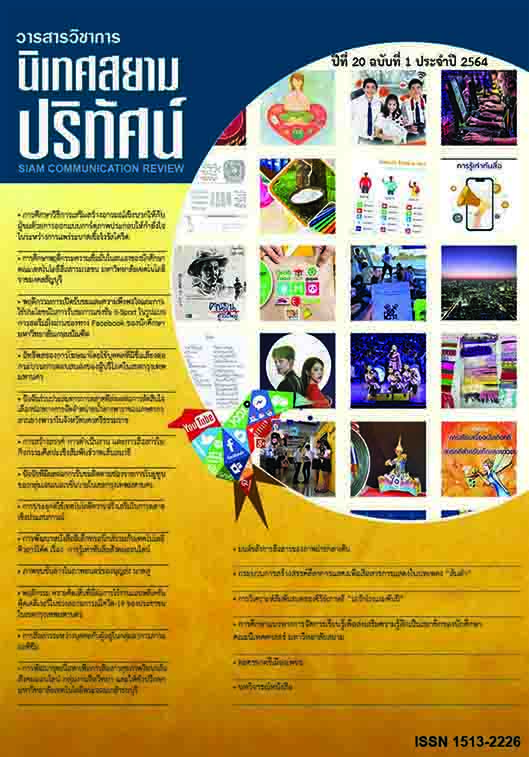A Study of Self-Confidence Behavior of Students in Faculty of Mass Communication Technology Rajamangala University of Technology Thanyaburi
Main Article Content
Abstract
This research aimed to study the self-confidence behavior of students in Faculty of Mass Communication Technology Rajamangala University of Technology Thanyaburi. The sample was the 400 undergraduate students, who had registered in the academic year 2018. The samples of this research were calculated by using Taro Yamane formula with 95% confidence level with the Multi Stage Random Sampling. Researcher analyzed data by using mean and standard deviation. The analysis results can be prioritized the self-confidence behavior of students in Faculty of Mass Communication Technology Rajamangala University of Technology Thanyaburi. The first order was the working with others which consisted of the question No.1: I can accept other people's opinions, if I was given a reasonable explanation. The mean was 4.31 ( = 4.31, SD = 0.695). The second order was the idea expression which consisted of the question No.2: I prefer to create a new way to do a variety of work rather than cooperating in any work which I did not agree. The mean was 4.12 (
= 4.12, SD = 0.649). The third order was self-esteem which consisted of the question No.6: I tended to set my career goals higher than usual level. The mean was 4.09 (
= 4.09, SD = 0.741). Considering the analysis results of self-confidence behavior of the students in all 6 majors of Faculty of Mass Communication Technology, it revealed that the first highest values were composed of 2 majors; Television and Radio Broadcasting Technology Program, and Advertising and Public Relations Technology Program.
Article Details
References
พนิดา มารุ่งเรือง และอัญชลี ทรัพยเกษม. (2552). ความเชื่อมั่นในตนเองของบัณฑิตมหาวิทยาลัยธนบุรีก่อนเข้าสู่สถานประกอบการ. กรุงเทพฯ: สำนักวิจัยและวางแผนพัฒนา มหาวิทยาลัยธนบุรี.
ล้วน สายยศ และอังคณา สายยศ. (2538). เทคนิคการวิจัยทางการศึกษา (พิมพ์ครั้งที่ 4). กรุงเทพฯ: สุวีริยาสาส์น.
วรากรณ์ สามโกเศศ. (2552, 18 มิถุนายน). รู้จักเศรษฐกิจสร้างสรรค์ (Creative Economy). มติชน, น. 6
สมจินตนา คุปตสุนทร. (2547) การศึกษาความเชื่อมั่นในตนเองของเด็กปฐมวัยที่ไดรับการจัดประสบการณ์การละเล่นพื้นบ้านของไทย. ปริญญานิพนธ การศึกษามหาบัณฑิต (การศึกษาปฐมวัย), มหาวิทยาลัยศรีนครินทรวิโรฒ.
สมใจ สืบเสาะ. (2555). การพัฒนารูปแบบการเรียนแบบสร้างสรรค์เชิงหรรษาบนเว็บเพื่อส่งเสริมความคิดสร้างสรรค์สำหรับนักศึกษาระดับปริญญาบัณฑิต. นนทบุรี: มหาวิทยาลัยเทคโนโลยีพระจอมเกล้าพระนครเหนือ.
อินทิรา พรมพันธ์. (2550). การพัฒนารูปแบบการเรียนการสอนบนเว็บ โดยใช้กระบวนการเรียนรู้แบบเบรนเบสด์ ในวิชาการออกแบบเพื่อพัฒนาความคิดสร้างสรรค์ของนิสิตนักศึกษาในระดับปริญญาบัณฑิต. วิทยานิพนธ์ครุศาสตรดุษฎีบัณฑิต สาขาวิชาเทคโนโลยีและการสื่อสารการศึกษา, จุฬาลงกรณ์มหาวิทยาลัย.
ภาษาอังกฤษ
Argyle, M. (2001). The psychology of happiness. New York: Rout ledge.
Denise de Souza Fleith, & other. (2002). Effects of Creativity Training Program on Divergent Thinking Abilities and Self-Concept in Monolingual and Bilingual Classrooms. Creativity Research Journal, 14(3-4), 373-386.
Gasper, K. (2004). Permission to seek freely The effect of happy and sad moods on generating old and new ideas. Creativity Research Journal, 16(2-3), 215-229.
Mayes, T. (2002). Learning technology and learning relationships. In Stephenson, J. (Ed.), Teaching and learning online: Pedagogies for new technologies (pp. 16-22). London: Kogan.


